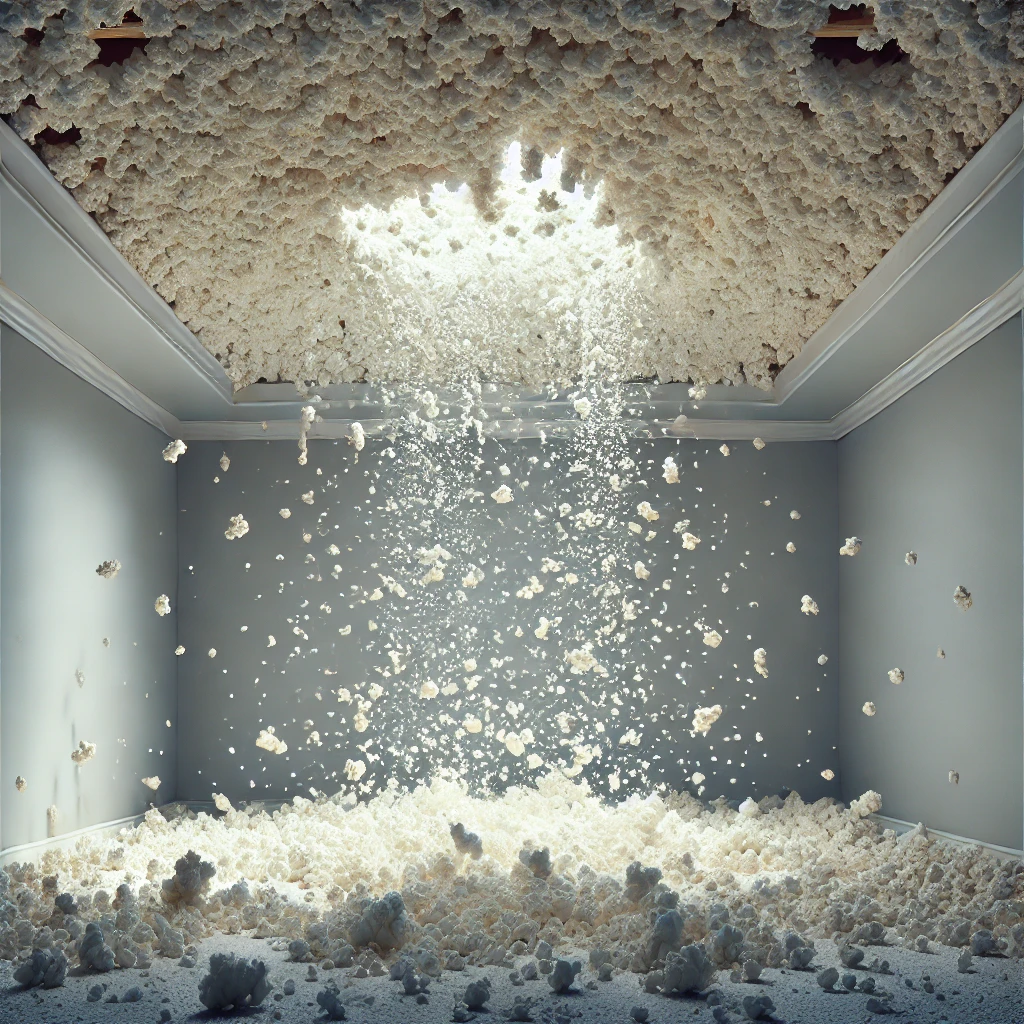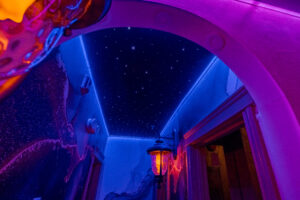When it comes to home renovations, one of the most significant concerns for homeowners is the presence of asbestos in older houses. Asbestos, a hazardous material commonly used in construction until the late 1970s, can be found in various building materials, including popcorn ceilings. In this blog, we will explore the dangers associated with asbestos and popcorn ceiling dust, and how Space Ceiling can help alleviate these risks with their innovative stretch ceiling solutions.
Asbestos, once hailed as a versatile and fire-resistant material, has since been linked to serious health conditions, including lung cancer and mesothelioma. Popcorn ceilings, popular in the mid-20th century, were often sprayed with a mixture containing asbestos fibers to enhance their fire resistance. Over time, these ceilings can deteriorate, releasing asbestos fibers into the air and posing a significant health risk to occupants.
The removal of popcorn ceilings is a challenging and potentially dangerous task. Disturbing the ceiling during removal can release asbestos fibers into the air, contaminating the entire space. That’s where Space Ceiling comes in with their expertise in providing a safe and effective solution.
Space Ceiling offers stretch ceiling solutions that can cover and isolate asbestos-laden popcorn ceilings, minimizing the risk of asbestos exposure. By installing a stretch ceiling over the existing popcorn ceiling, Space Ceiling creates a protective barrier, preventing the release of asbestos fibers into the air. This approach eliminates the need for costly and hazardous removal procedures, providing homeowners with a safer and more cost-effective alternative.
In addition to addressing the asbestos concern, Space Ceiling’s stretch ceilings offer several other benefits. The smooth and flawless finish of stretch ceilings enhances the aesthetic appeal of any space. The customizable options, such as various colors, textures, and finishes, allow homeowners to transform their ceilings into stunning design features that complement their overall interior design.
Stretch ceilings are easy to maintain and clean, as they are resistant to moisture, mold, and stains. Unlike popcorn ceilings, which can collect dust and become a breeding ground for allergens, stretch ceilings provide a hygienic and allergy-free environment. Regular cleaning of the stretch ceiling surface requires only gentle wiping, ensuring a healthy and comfortable living space for homeowners.
By choosing Space Ceiling’s stretch ceiling solutions, homeowners not only address the danger of asbestos and popcorn ceiling dust but also enhance the overall safety, aesthetics, and cleanliness of their homes. Space Ceiling’s certified installers ensure a hassle-free installation process, completing the project with efficiency and expertise.
The presence of asbestos and popcorn ceiling dust in older houses poses significant health risks to homeowners and their families. However, with Space Ceiling’s stretch ceiling solutions, homeowners can effectively mitigate these dangers by covering and isolating asbestos-laden popcorn ceilings. By choosing a stretch ceiling, homeowners can transform their space into a safe, beautiful, and worry-free environment. Trust Space Ceiling to provide the expertise and solutions needed to address the danger from above and create a home that is both stylish and safe.
Introduction
Cleaning your ceiling is an essential part of maintaining a clean and healthy home. When cleaning, especially popcorn ceilings, it is crucial to wear a dust mask to protect yourself from inhaling dust and potential asbestos fibers. Over time, ceilings can accumulate dust, dirt, and stains, which can be challenging to remove. In this article, we will provide you with a comprehensive guide on how to clean your ceiling, including popcorn ceilings, and offer tips on how to prevent future dust and stains. Whether you’re dealing with a textured ceiling or a smooth surface, keeping your ceiling clean can significantly improve the overall air quality and aesthetic of your home.
Understanding the Risks of Popcorn Ceilings
Popcorn ceilings, also known as acoustic ceilings, were popular in homes built between the 1950s and 1980s. These ceilings were designed to reduce noise and hide imperfections, making them a practical choice for many homeowners. However, they can also pose significant health risks due to the presence of asbestos. Asbestos was commonly used in the production of popcorn ceilings for its fire-resistant properties. When these ceilings are disturbed, they can release harmful asbestos fibers into the air, which can be inhaled and cause serious health issues. Understanding these risks is crucial for anyone considering cleaning or removing their popcorn ceiling.
Identifying Types of Ceilings

Before you start cleaning your ceiling, it’s essential to identify the type of ceiling you have. There are several types of ceilings, including flat ceilings, textured ceilings, and popcorn ceilings. Flat ceilings are smooth and flat, while textured ceilings have a rough, bumpy surface. Popcorn ceilings, also known as acoustic ceilings, have a textured surface with small, rounded bumps.
Identifying the type of ceiling you have will help you determine the best cleaning method and tools to use. For example, flat ceilings can be cleaned with a simple dusting or vacuuming, while textured ceilings may require a more specialized cleaning tool, such as a vacuum with a HEPA filter and a long extension wand and soft-bristled attachment. Knowing your ceiling type ensures you use the right approach, preventing damage and ensuring effective cleaning.
Identifying and Removing Asbestos with a Dust Mask
If you suspect that your popcorn ceiling contains asbestos, it is crucial to have it tested by a professional. Asbestos testing involves collecting a sample of the ceiling material and analyzing it in a laboratory. If the test results confirm the presence of asbestos, it is recommended to hire a licensed asbestos removal contractor to safely remove the ceiling. Removing asbestos-containing materials can be hazardous, and it is not recommended to attempt to do it yourself. Professional contractors have the necessary equipment and expertise to handle asbestos safely, ensuring that your home remains a safe environment.
Preparing to Clean Your Ceiling
Before you start cleaning your ceiling, make sure you have the necessary tools and materials. You’ll need a ladder or step stool to reach high ceilings safely, as well as protective gear such as gloves and goggles to protect yourself from chemicals and splashes. You’ll also need a drop cloth or plastic sheeting to protect the floor and furniture from spills and drips.
In addition to these basic tools, you may also need a cleaning solution, such as a pH-neutral all-purpose cleaner or a DIY formula made with liquid dish soap and water. You’ll also need a microfiber cloth or soft sponge to apply the cleaning solution and remove dust and dirt. Proper preparation ensures a smooth cleaning process and helps you avoid any potential mess or damage.
Cleaning Ceilings

Cleaning your ceiling can be a straightforward process, but it requires some care and attention to detail. Here are the steps to follow:
Remove dust and loose debris from the ceiling using a duster, vacuum cleaner with a brush attachment, or a dry microfiber cloth.
Mix a cleaning solution according to the manufacturer’s instructions or use a DIY formula made with liquid dish soap and water.
Dip a soft cleaning cloth or sponge into the cleaning solution and wring out any excess liquid.
Gently scrub the ceiling with a damp cloth or sponge, working in small sections at a time.
Avoid applying too much pressure to prevent damage to the ceiling surface.
Rinse the cloth or sponge in clean water and wring it out.
Use a damp cloth or sponge to wipe away the cleaner from the ceiling, removing the loosened dust and dirt.
Repeat the process as needed, changing the water and cleaning cloth/sponge as they become dirty.
By following these steps, you can effectively remove dust and dirt from your ceiling, ensuring a clean and fresh appearance.
Removing Stains from Ceilings
Removing stains from ceilings can be a bit more challenging than cleaning the ceiling itself. Here are some tips for removing different types of stains:
Water-based stains: Use an all-purpose cleaner to remove water-based stains from ceilings.
Oil-based stains: Use liquid dish soap to remove oil-based stains from ceilings.
Tough stains: Use a paste made with baking soda and water to absorb and remove stubborn stains from ceilings.
Popcorn ceiling stains: Use a thick nap paint roller or a soft sponge to apply a cleaning solution to the stained area. Rinse the roller or sponge frequently as you go to prevent damage to the texture.
In addition to these tips, you can also use a stain-blocking primer to cover stains on your ceiling. This can be especially useful if you’re planning to paint your ceiling and want to ensure that the stain doesn’t show through.
Remember to always test a small, inconspicuous area of the ceiling before applying any cleaning solution or stain remover to make sure it won’t damage the paint or finish. By following these tips, you can effectively remove stains and keep your ceiling looking pristine.
The Impact of Asbestos and Dust on Indoor Air Quality
Asbestos and dust can significantly impact indoor air quality, posing health risks to occupants. When asbestos fibers are released into the air, they can be inhaled, causing respiratory problems and increasing the risk of lung cancer. Dust, on the other hand, can aggravate respiratory issues such as asthma and allergies. Regular cleaning and maintenance of your ceiling can help reduce the amount of dust and asbestos fibers in the air, improving indoor air quality. Using a damp cloth or a soft sponge to gently wipe down your ceiling can help remove dust without disturbing any potential asbestos fibers.
Preventing Future Dust and Remove Dust Stains
To prevent future dust and stains on your ceiling, it is essential to maintain good ventilation and air circulation. Ensure that your air vents are clean and unobstructed, and consider installing a ceiling fan to improve air circulation. Regularly dusting your ceiling with a microfiber cloth or a dry microfiber cloth can also help reduce the amount of dust that accumulates. Additionally, using a stain-blocking primer on your ceiling can help prevent stains from forming. For textured ceilings, a thick nap paint roller can be used to apply the primer evenly. By taking these preventive measures, you can keep your ceiling looking clean and fresh for years to come.
Trustindex verifies that the original source of the review is Google. Space Ceiling did an amazing job! It looks awesome, my wife loves it too and Aivaras was very clear and efficient. I think the price was also fair compared to other stretch ceiling providers. I can't tell you how glad I am not having to see or repaint those popcorn ceilings ever againTrustindex verifies that the original source of the review is Google. I've used Space Ceiling on a number of projects. I cant express how highly i recommend you use them. The product is spectacular and long lasting and esthetically pleasing. The workmanship of the owners is top notch. Service, follow up, value, professionalism. If you are considering using them, i encourage you to proceed.Trustindex verifies that the original source of the review is Google. Thank you to space ceiling for giving us this dope look throughout our entire lounge!!! The vibes are killer!!!Trustindex verifies that the original source of the review is Google. We had Space Ceiling install stretch ceilings in our basement (den and bedroom). We couldn't be happier! It transformed our dark basement with popcorn ceilings into a bright and clean modern space to enjoy. All our family wanted to come by to see what a stretch ceiling was and loved it! We even had neighbours come knocking on our door because they had seen the 'Space Ceiling' logo on vehicles in my driveway. They also loved it which led to more neighbours coming to look. All the staff and workers involved were very friendly and kept us informed as to what they were doing as the job progressed. We will definitely give Space Ceiling a call to help on our next renovation!Trustindex verifies that the original source of the review is Google. Excellent work and innovative product. Darius and Volo are amazing ceiling experts. The new ceiling is a significant upgrade to our property Thanks a lotTrustindex verifies that the original source of the review is Google. I recently had Christopher help me out with understanding modern stretch ceiling for a project and it was wonderful customer service.Trustindex verifies that the original source of the review is Google. Aivaras and his crew were great to deal with. He answered all my questions and showed me all the options. The transformation from popcorn to stretch ceiling was quick, affordable, and so worth it! Everyone that comes over is in awe of it. I highly recommend this company!Trustindex verifies that the original source of the review is Google. The guys from Spaceiling Stretch Ceiling have done the absolutely amazing transformation from popcorn ceiling to the modern and beautiful ceiling in our Dance Studio. It looks so awesome!!! 🔥🔥🔥 Awesome job and affordable price! It is the best ceiling that I have seen in my life! Come and check it out👍🔥 I definitely recommend this company to everyone!👍 Thank you very much Spaceiling!Trustindex verifies that the original source of the review is Google. Got it installed in my shower. Looking modern. Popcorn gone. Strongly recomend these guys.Trustindex verifies that the original source of the review is Google. Highly recommend Spaceiling Stretch Ceiling, they did an amazing transformation from popcorn ceiling to nice gloce one in my bathroom. Finally no more falling popcorn. Im really loveing it. Thank you.Verified by TrustindexTrustindex verified badge is the Universal Symbol of Trust. Only the greatest companies can get the verified badge who has a review score above 4.5, based on customer reviews over the past 12 months. Read more
Originally posted on December 9, 2024 @ 2:41 am



